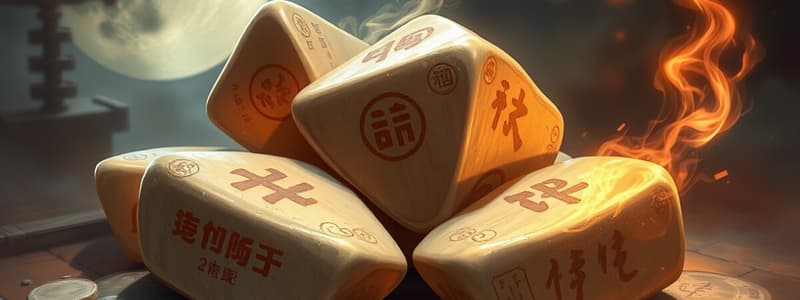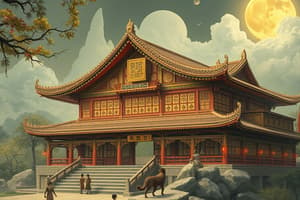Podcast
Questions and Answers
What time period does the creation of most runestones fall into?
What time period does the creation of most runestones fall into?
- 4th century to 12th century (correct)
- 1st century to 3rd century
- 13th century to 15th century
- 16th century to 18th century
Where are runestones primarily found?
Where are runestones primarily found?
- Scandinavia and regions with Norsemen (correct)
- North America and South America
- Western Europe and Eastern Europe
- Asia and Africa
What impact did the invention of the camera in the 1800s have on historical representation?
What impact did the invention of the camera in the 1800s have on historical representation?
- It made historical artifacts more valuable.
- It eliminated the need for written history.
- It changed the way history was visually represented. (correct)
- It allowed for fictional stories to be produced.
What challenge do filmmakers face when depicting historical figures?
What challenge do filmmakers face when depicting historical figures?
How many runestones exist among the runic inscriptions in Scandinavia?
How many runestones exist among the runic inscriptions in Scandinavia?
What materials are commonly used for oracle bones?
What materials are commonly used for oracle bones?
During which Chinese dynasties were oracle bones primarily used?
During which Chinese dynasties were oracle bones primarily used?
What is the main purpose of oracle bones in ancient China?
What is the main purpose of oracle bones in ancient China?
What technique was applied to oracle bones after carving questions onto them?
What technique was applied to oracle bones after carving questions onto them?
What characterizes a geoglyph?
What characterizes a geoglyph?
Which is a well-known example of geoglyphs?
Which is a well-known example of geoglyphs?
What is the cultural significance of geoglyphs like the Nazca Lines?
What is the cultural significance of geoglyphs like the Nazca Lines?
What type of land art is formed by arrangement and alignment of materials on the ground?
What type of land art is formed by arrangement and alignment of materials on the ground?
What was a common location for early runestones?
What was a common location for early runestones?
Which statement accurately describes the historical significance of the invention of the camera?
Which statement accurately describes the historical significance of the invention of the camera?
What was a typical characteristic of early runestones?
What was a typical characteristic of early runestones?
Which factor complicates the casting process for films set in photographed historical periods?
Which factor complicates the casting process for films set in photographed historical periods?
During what period were most runestones created?
During what period were most runestones created?
What is primarily used to create the inscriptions found on oracle bones?
What is primarily used to create the inscriptions found on oracle bones?
What was the purpose of applying intense heat to oracle bones?
What was the purpose of applying intense heat to oracle bones?
Which of the following best describes a positive geoglyph?
Which of the following best describes a positive geoglyph?
What is a defining feature of hill figures as a type of geoglyph?
What is a defining feature of hill figures as a type of geoglyph?
What is the earliest known form of Chinese writing found on oracle bones?
What is the earliest known form of Chinese writing found on oracle bones?
Which ancient civilization is primarily associated with the creation of geoglyphs like the Nazca Lines?
Which ancient civilization is primarily associated with the creation of geoglyphs like the Nazca Lines?
What uncertainty surrounds the cultural significance of geoglyphs?
What uncertainty surrounds the cultural significance of geoglyphs?
Approximately how many different characters are inscribed on oracle bones?
Approximately how many different characters are inscribed on oracle bones?
What is a significant challenge faced by producers of stories set in photographed historical times?
What is a significant challenge faced by producers of stories set in photographed historical times?
What typically characterized the physical appearance of early runestones when they were first created?
What typically characterized the physical appearance of early runestones when they were first created?
How has the existence of photographs impacted the representation of historical events and figures for filmmakers?
How has the existence of photographs impacted the representation of historical events and figures for filmmakers?
What aspect of casting actors for historical portrayals is debated in the context of achieved physical resemblance?
What aspect of casting actors for historical portrayals is debated in the context of achieved physical resemblance?
In which geographical context are runestones predominantly found?
In which geographical context are runestones predominantly found?
What is the primary purpose of diviners using oracle bones in ancient China?
What is the primary purpose of diviners using oracle bones in ancient China?
Which of the following best describes the method used to interpret oracle bones after the heating process?
Which of the following best describes the method used to interpret oracle bones after the heating process?
What defines a geoglyph as opposed to other forms of land art?
What defines a geoglyph as opposed to other forms of land art?
Which characteristic is unique to hill figures among various types of geoglyphs?
Which characteristic is unique to hill figures among various types of geoglyphs?
Which statement about the characters found on oracle bones is accurate?
Which statement about the characters found on oracle bones is accurate?
What is a notable aspect of the cultural significance of geoglyphs like the Nazca Lines?
What is a notable aspect of the cultural significance of geoglyphs like the Nazca Lines?
Which feature distinguishes oracle bone script from other ancient writing systems?
Which feature distinguishes oracle bone script from other ancient writing systems?
What type of questions were typically carved onto oracle bones?
What type of questions were typically carved onto oracle bones?
Flashcards are hidden until you start studying
Study Notes
Oracle Bones
- Oracle bones, typically the shoulder blades of oxen or turtle shells, feature ancient Chinese symbols.
- Dating back to the Shang Dynasty (1600–1046 BC) and the Zhou Dynasty (1046–226 BC).
- Used by diviners to forecast the future and answer questions posed to deities regarding various aspects like weather and military endeavors.
- Questions were engraved on the bones using sharp tools and interpreted through the patterns of cracks after heating.
- Represent the earliest corpus of significant ancient Chinese writing with around 5,000 distinct characters.
Geoglyphs
- Geoglyphs are large ground designs or motifs exceeding 4 meters, crafted from landscape materials like stones or earth.
- Mostly produced by Native American cultures, particularly the Peruvians.
- Positive geoglyphs involve arranging materials akin to petroforms, often classified as land or rock art.
- The famous Nazca Lines in Peru, featuring designs such as a hummingbird, exemplify notable geoglyphs.
- Numerous geoglyphs have emerged in Brazil's Amazon rainforest from the 1970s, hinting at Pre-Columbian civilizations.
Runestones
- Runestones are boulders or rocks inscribed with runes, predominantly from the 4th to the 12th century.
- Primarily found in Scandinavia, these stones were often placed near graves during the Late Viking Age.
- Approximately 3,000 runestones exist among about 6,000 runic inscriptions discovered in Scandinavia.
- Initially colorful, modern runestones have faded significantly over time due to weathering and erosion.
Oracle Bones
- Oracle bones, typically the shoulder blades of oxen or turtle shells, feature ancient Chinese symbols.
- Dating back to the Shang Dynasty (1600–1046 BC) and the Zhou Dynasty (1046–226 BC).
- Used by diviners to forecast the future and answer questions posed to deities regarding various aspects like weather and military endeavors.
- Questions were engraved on the bones using sharp tools and interpreted through the patterns of cracks after heating.
- Represent the earliest corpus of significant ancient Chinese writing with around 5,000 distinct characters.
Geoglyphs
- Geoglyphs are large ground designs or motifs exceeding 4 meters, crafted from landscape materials like stones or earth.
- Mostly produced by Native American cultures, particularly the Peruvians.
- Positive geoglyphs involve arranging materials akin to petroforms, often classified as land or rock art.
- The famous Nazca Lines in Peru, featuring designs such as a hummingbird, exemplify notable geoglyphs.
- Numerous geoglyphs have emerged in Brazil's Amazon rainforest from the 1970s, hinting at Pre-Columbian civilizations.
Runestones
- Runestones are boulders or rocks inscribed with runes, predominantly from the 4th to the 12th century.
- Primarily found in Scandinavia, these stones were often placed near graves during the Late Viking Age.
- Approximately 3,000 runestones exist among about 6,000 runic inscriptions discovered in Scandinavia.
- Initially colorful, modern runestones have faded significantly over time due to weathering and erosion.
Oracle Bones
- Oracle bones, typically the shoulder blades of oxen or turtle shells, feature ancient Chinese symbols.
- Dating back to the Shang Dynasty (1600–1046 BC) and the Zhou Dynasty (1046–226 BC).
- Used by diviners to forecast the future and answer questions posed to deities regarding various aspects like weather and military endeavors.
- Questions were engraved on the bones using sharp tools and interpreted through the patterns of cracks after heating.
- Represent the earliest corpus of significant ancient Chinese writing with around 5,000 distinct characters.
Geoglyphs
- Geoglyphs are large ground designs or motifs exceeding 4 meters, crafted from landscape materials like stones or earth.
- Mostly produced by Native American cultures, particularly the Peruvians.
- Positive geoglyphs involve arranging materials akin to petroforms, often classified as land or rock art.
- The famous Nazca Lines in Peru, featuring designs such as a hummingbird, exemplify notable geoglyphs.
- Numerous geoglyphs have emerged in Brazil's Amazon rainforest from the 1970s, hinting at Pre-Columbian civilizations.
Runestones
- Runestones are boulders or rocks inscribed with runes, predominantly from the 4th to the 12th century.
- Primarily found in Scandinavia, these stones were often placed near graves during the Late Viking Age.
- Approximately 3,000 runestones exist among about 6,000 runic inscriptions discovered in Scandinavia.
- Initially colorful, modern runestones have faded significantly over time due to weathering and erosion.
Studying That Suits You
Use AI to generate personalized quizzes and flashcards to suit your learning preferences.




